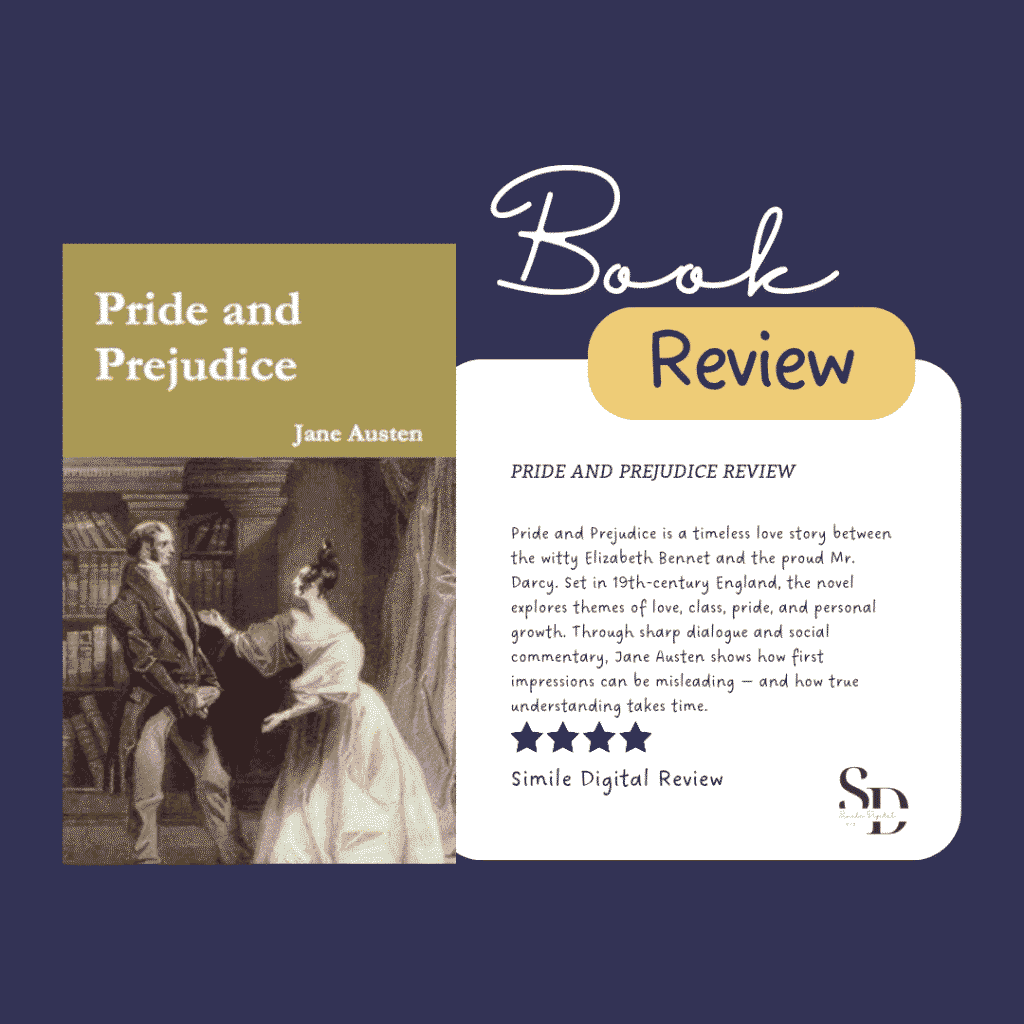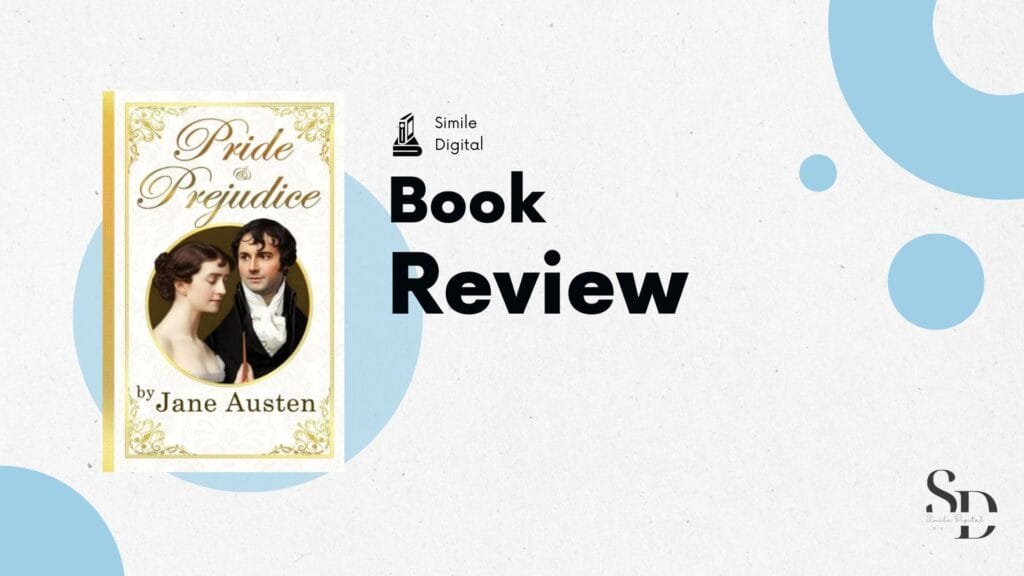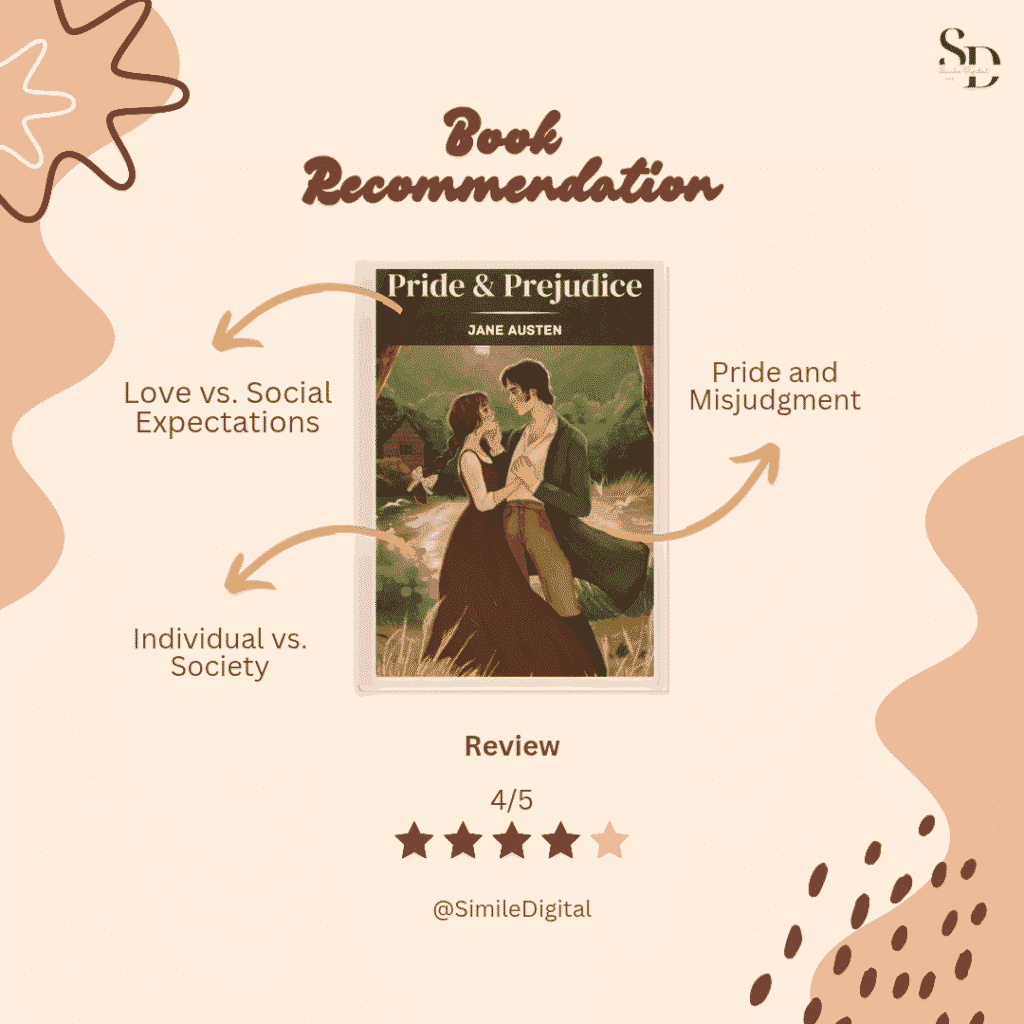Pride and Prejudice Review – Discover the characters, themes, and enduring literary influence of Jane Austen’s classic novel by reading our Pride and Prejudice Review.

Table of Contents
Introduction
Jane Austen, a well-known British author, wrote Pride and Prejudice, one of the most cherished books in English literature, which was first released in 1813. The book has enthralled readers for more than 200 years and is well-known for its wit, compelling characters, and incisive social satire. It centers on the vivacious Elizabeth Bennet and the arrogant Mr. Darcy as they negotiate love, class, and miscommunication in rural England in the early 19th century. Jane Austen, who is renowned for her astute observations of social mores and human nature, wrote this book as a romantic and humorous indictment of the marriage market of her era. Pride and Prejudice’s timeless appeal means that it still has resonance with contemporary audiences worldwide.
Book Name: Pride and Prejudice
Author: Jane Austen
Pages: Approximately 432 pages (may vary slightly by edition)
Pride and Prejudice Review
Pride and Prejudice by Jane Austen is more than just a romance. It’s a perceptive and intelligent examination of relationships, society, and human decision-making, particularly when pride and initial impressions get in the way. The protagonist of the tale is Elizabeth Bennet, a bright, self-assured young lady who rejects marriage based only on wealth or social standing. Although it wasn’t a popular belief in the early 1800s, she wants to marry for love. Then there’s Mr. Darcy, a wealthy man who at first seems cold and arrogant. However, as the narrative progresses, we discover that he is more complex than first appears.
The power of the book lies in their bond. They initially misinterpret one another. Elizabeth believes Darcy is conceited. In contrast, Darcy believes Elizabeth is beneath him. However, they both start to alter as they learn more about one another. Elizabeth acknowledges that she could have passed judgment on Darcy too hastily, and Darcy learns to swallow his pride.
The characters’ sense of realism is what distinguishes Pride and Prejudice. Jane Austen creates beloved yet imperfect characters. Despite social and familial pressure, Elizabeth doesn’t back down from her opinions. Despite first seeming aloof, Darcy eventually becomes giving and caring. Even the supporting cast, such as the wacky Mr. Collins and the tragic Mrs. Bennet, give the narrative depth and humor.

The book delves into significant topics as well. It examines the expectation that women would marry successfully in order to ensure their future. Class distinctions and how people evaluate one another based on family name or income are discussed. The term “pride” and “prejudice” are taken from the title, which illustrates how hazardous it may be to make judgments about people you don’t really know. It’s amazing how Austen makes all these weighty subjects entertaining to read about. Her work is witty and frequently humorous. Conversations seem authentic. Even now, her descriptions of uncomfortable social settings, awkward proposals, and stressful family dinners are familiar.
The scene where Mr. Darcy initially pops the question to Elizabeth is among the most memorable. It becomes a quarrel instead of a beautiful moment, but it’s precisely what they need to start viewing things differently. This book’s beauty lies in its slow onset of romance. It develops it gradually, honestly, and progressively. When Darcy and Elizabeth eventually come to terms with and accept one another at the book’s conclusion, it feels genuinely earned. Their love is based on respect for one another, learning, and growth; it is neither flawless nor simple. And for that reason, this tale has endured and continues to have an impact on readers to this day.
Pride and Prejudice is a classic for a reason, to put it briefly. Not everything is about balls and bonnets. It’s about developing the ability to forgive, look past appearances, and mature. The heartfelt, humorous, and truthful tale that Jane Austen penned has the same significance today as it did two centuries ago.
Top 10 Best Quotes from Pride and Prejudice
- It is a truth universally acknowledged, that a single man in possession of a good fortune, must be in want of a wife.
– Opening line; a satirical take on societal expectations about marriage. - I could easily forgive his pride if he had not mortified mine.
– Elizabeth Bennet on Mr. Darcy; reflects personal pride and emotional hurt. - Vanity and pride are different things, though the words are often used synonymously.
– Mary Bennet; distinguishes between two central themes. - You must allow me to tell you how ardently I admire and love you.
– Mr. Darcy’s first proposal; a turning point in the story. - My good opinion once lost, is lost forever.
– Mr. Darcy; shows his initial rigidity in judgment. - Till this moment I never knew myself.
– Elizabeth; when she realizes her misjudgments about Darcy. - We are all fools in love.
– Charlotte Lucas; a comment on romantic decisions and society. - Think only of the past as its remembrance gives you pleasure.
– Elizabeth; showing growth and learning from past mistakes. - To be fond of dancing was a certain step towards falling in love.
– A humorous observation of social customs in courtship. - There is a stubbornness about me that never can bear to be frightened at the will of others.
– Elizabeth asserting her independence and strong will.
Other Highly Recommended Books by Jane Austen
- Sense and Sensibility (1811)
A story of two sisters — one practical, one emotional — navigating love, loss, and societal expectations. - Emma (1815)
Follows a charming but meddling matchmaker who learns humility and the true nature of love. - Persuasion (1817)
A deeply emotional story about second chances, regret, and enduring love. - Northanger Abbey (1817, posthumous)
A playful parody of Gothic novels, featuring a naive heroine learning the difference between fiction and reality. - Mansfield Park (1814)
A more serious novel exploring morality, social class, and integrity through the quiet strength of Fanny Price.
Conclusion
Pride and Prejudice is one of the few books that has gracefully endured over the years. Even though the novel takes place in the early 1800s, its themes, characters, and feelings are relevant today. Jane Austen wrote about more than just love; she also wrote about miscommunications, maturation, peer pressure, and the internal struggles we all have while forming judgments about other people. Austen provided us with a heroine who values education, self-reliance, and individual dignity in Elizabeth Bennet. Through Mr. Darcy, she demonstrated that when people are willing to think and develop, they may change and improve. We are reminded by their narrative that love is about accepting and understanding one another, not about being flawless.

The book also provides incisive and nuanced societal analysis. It challenges the notion of marrying for money, draws attention to the few options open to women, and looks at the strict class systems of the day. It accomplishes all of this, though, with heart, grace, and comedy. For readers who enjoy character-driven stories, rich dialogue, and themes that still feel relevant, Pride and Prejudice is a must-read. In addition to reflecting human nature, it serves as a window and a mirror, providing a window into a world that is both familiar and remote. This novel is not just a classic, but also a delight because of Jane Austen’s timeless, humorous, and smart writing.
Book Link
You can easily find The Book in both physical and digital formats
E-Book: Available on Kindle, Google Books, Apple Books, and Kobo
Paperback/Hardcover: Available in local bookstores and major online retailers like Amazon, Flipkart
Audiobook: Available on Audible, Spotify, and Google Play
Thank You Note
Thank you for taking the time to read this detailed review of Pride and Prejudice. Whether you’re revisiting this classic or discovering it for the first time, I hope this guide helped you connect more deeply with its story and characters. Literature has a unique way of bringing people together across time, and with Jane Austen’s timeless work, we’re reminded that good stories — like good people — never go out of style.
Happy reading!
For more comparisons, insights and review visit our blog regularly. If you have any questions or suggestions, feel free to leave a comment or contact us directly.
Frequently Asked Questions (FAQs)
How does Elizabeth Bennet stand out as a character?
Why is Mr. Darcy so popular?
What age group is this book suitable for?
Is Pride and Prejudice just a love story?
Is the story still relevant today?
Is Pride and Prejudice hard to read?
What is the main message of Pride and Prejudice?
Note for Readers
If you’d like to read this blog in your regional language or any other international language, simply click on the Google Translator option located in the bar at the top of the page. This feature allows you to select your preferred language and enjoy the content in a way that’s comfortable for you. We hope this makes your reading experience more enjoyable and accessible!
Disclaimer
This review is based on the public domain novel Pride and Prejudice by Jane Austen, originally published in 1813. All opinions expressed are personal, unbiased, and written for educational and literary discussion purposes. No part of this content infringes on any copyright laws.
For more exciting topics, explore our other articles here
- Adolescence Review
- The Boy, the Mole, the Fox, and the Horse Review
- The Alchemist Review
- 10 Best Malayalam Movies Dubbed in Hindi (24–25)
- Top 5 Comedy Sitcoms Available on Hotstar Vs. Apple TV – A Laughter Showdown!
- Top 10 Sitcoms Available on Netflix Vs. Aws
- Top 10 Series Available on Disney+ Hotstar vs Jio Cinema
- Bollywood Top 15 Actors Vs Actresses
- Netflix vs Amazon: Top 5 Indian Series Showdown
- Netflix vs Amazon Prime: Top 10 Must-Watch Shows
- Coffee vs. Tea: Which Drink is Healthier?
- Green Tea vs. Black Tea: Taste, Health, and Tradition
5 Comments